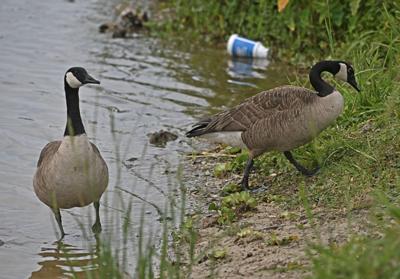This week, Stephen Storey has written in to ask about an increasingly visible part of the local landscape.
"It seems like in the last 10 years or so, the local Canadian goose population has grown by leaps and bounds," he wrote. "Years ago, you would see one now and then. Now they are everywhere YEAR ROUND, especially golf courses! Why has the local goose population expanded so rapidly in the last few years? Inquiring minds want to know."
Canada geese are a constant presence in urban areas throughout the United States, noisily gathering in urban spaces to honk, waddle, and, well, create loads of waste. Given how ubiquitous they are, it's perhaps surprising to know that it wasn't always this way. The geese were once so endangered that, early in the previous century, breeding programs and protective measures were put in place to ensure they didn't meet a species-wide demise.
Around the 1960s, the measures appeared to be working, but relief soon gave way to consternation as the geese started doing a little too well for themselves. According to the USDA, between 1970 and 2010 their population increased from 250,000 to 3.5 million.
The reason for their success is that Canada geese love urban areas, have few natural predators, and have high survival rates. While they have historically been migratory, flying south to non-breeding sites during cold weather and returning north once things warm up, most of the recent population increase across the country appears to be primarily due to settled, resident populations.
James Remsen, of LSU's Museum of Natural Science and Department of Biological Sciences, has been keeping an eye on the geese for decades. He says it's true: Not long ago, the birds were indeed relative strangers in the Baton Rouge area.
"The person who asked the question is definitely correct," he wrote. "Canada geese as a resident population here in Baton Rouge, and throughout much of Louisiana, has exploded during the last decade."
According to a master's thesis written by former LSU student Matt Brady, Canada geese populations in Louisiana started with a small group released by Louisiana Department of Wildlife and Fisheries staff in the southwestern part of the state in the 1960s, which had become resident and started to expand by 1973. By 1979, another population had become established at LSU's Aquaculture Research Center south of Baton Rouge, though whether that was introduced deliberately or otherwise is unclear.
Nevertheless, these populations remained small for decades. A 1994 breeding bird atlas by former LSU students David Wiedenfeld and Mark Swan, sponsored and published by the Louisiana Department of Wildlife and Fisheries, makes no mention of the bird in the Baton Rouge area, though subsequent maps reveal an increase in both summer and winter populations between 2007 and 2013.
According to Jason Olszak, from the Louisiana Department of Wildlife and Fisheries, most of the geese seen around Baton Rouge are likely locals.
"Canada geese, though protected by the Federal Migratory Bird Treaty Act, are in fact year-round (nonmigratory) residents of urban and suburban areas throughout Louisiana," he wrote. "They are nearly the only Canada geese we have in the state, as migratory populations are rarely encountered anymore. Resident geese tend to only increase because they spend most of their time in urban areas (parks, golf courses, residential neighborhoods, airports) where the survival rate is high for both adults and juveniles."
So why here, and why now? While there doesn't appear to be a definitive answer, it's likely that their population here is part of a larger boom in Canada geese populations across the country. For his part, Remsen suspects the local resident population may be supplemented by continued immigration of birds from even healthier populations to the north.
They're certainly hard to get rid of. "Goose hazing techniques — noise makers, streamers, fencing, predator decoys — that make local areas inhospitable can be one method to reduce goose numbers, but their efficacy is often short-lived," Olszak wrote. The most effective control method tends to be egg and nest depredation (read: destruction), though that can only be done with a permit. Destroying eggs can also make for ethical concerns, as evidenced by various community battles in a number of northern states.
Either way, it appears the geese are here to stay.
Mind your step, now.
Curious Louisiana is a community-driven reporting project that connects readers to our newsrooms' resources to dig, research and find answers about the Pelican State. Bottom line: If you've got a question about something Louisiana-centric, ask us at curiouslouisiana@theadvocate.com.

